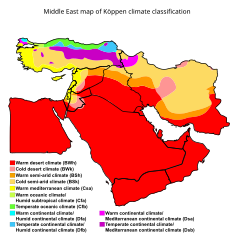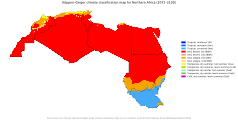
Back التغير المناخي في الشرق الأوسط وشمال إفريقيا Arabic Folgen der globalen Erwärmung im Nahen Osten und Nordafrika German Cambio climático en el Medio Oriente y África del Norte Spanish Changement climatique au Moyen-Orient et en Afrique du Nord French Canjin yanayi a Gabas ta Tsakiya da Arewacin Afirka Hausa Mabadiliko ya tabianchi Mashariki ya Kati na Afrika Kaskazini Swahili
Climate change in the Middle East and North Africa (MENA) refers to changes in the climate of the MENA region and the subsequent response, adaption and mitigation strategies of countries in the region. In 2018, the MENA region emitted 3.2 billion tonnes of carbon dioxide and produced 8.7% of global greenhouse gas emissions (GHG)[1] despite making up only 6% of the global population.[2] These emissions are mostly from the energy sector,[3] an integral component of many Middle Eastern and North African economies due to the extensive oil and natural gas reserves that are found within the region.[4][5] The region of Middle East is one of the most vulnerable to climate change. The impacts include increase in drought conditions, aridity, heatwaves and sea level rise.
Sharp global temperature and sea level changes, shifting precipitation patterns and increased frequency of extreme weather events are some of the main impacts of climate change as identified by the Intergovernmental Panel on Climate Change (IPCC).[6] The MENA region is especially vulnerable to such impacts due to its arid and semi-arid environment, facing climatic challenges such as low rainfall, high temperatures and dry soil.[6][7] The climatic conditions that foster such challenges for MENA are projected by the IPCC to worsen throughout the 21st century.[6] If greenhouse gas emissions are not significantly reduced, part of the MENA region risks becoming uninhabitable before the year 2100.[8][9][10]
Climate change is expected to put significant strain on already scarce water and agricultural resources within the MENA region, threatening the national security and political stability of all included countries.[11] Over 60 percent of the region's population lives in high and very high water-stressed areas compared to the global average of 35 percent.[12] This has prompted some MENA countries to engage with the issue of climate change on an international level through environmental accords such as the Paris Agreement. Law and policy are also being established on a national level amongst MENA countries, with a focus on the development of renewable energies.[13]
- ^ "CO2 Emissions". Global Carbon Atlas. Archived from the original on Oct 11, 2020. Retrieved 2020-04-10.
- ^ "Population, total – Middle East & North Africa, World". World Bank Open Data. Retrieved 2020-04-11.
- ^ Abbass, Rana Alaa; Kumar, Prashant; El-Gendy, Ahmed (February 2018). "An overview of monitoring and reduction strategies for health and climate change related emissions in the Middle East and North Africa region" (PDF). Atmospheric Environment. 175: 33–43. Bibcode:2018AtmEn.175...33A. doi:10.1016/j.atmosenv.2017.11.061. ISSN 1352-2310. Archived (PDF) from the original on Jun 14, 2021 – via Surrey Research Insight Open Access.
- ^ Al-mulali, Usama (2011-10-01). "Oil consumption, CO2 emission and economic growth in MENA countries". Energy. 36 (10): 6165–6171. doi:10.1016/j.energy.2011.07.048. ISSN 0360-5442.
- ^ Tagliapietra, Simone (2019-11-01). "The impact of the global energy transition on MENA oil and gas producers". Energy Strategy Reviews. 26: 100397. doi:10.1016/j.esr.2019.100397. ISSN 2211-467X.
- ^ a b c IPCC, 2014: Climate Change 2014: Synthesis Report. Contribution of Working Groups I, II and III to the Fifth Assessment Report of the Intergovernmental Panel on Climate Change [Core Writing Team, R.K. Pachauri and L.A. Meyer (eds.)]. IPCC, Geneva, Switzerland, 151 pp.
- ^ El-Fadel, M.; Bou-Zeid, E. (2003). "Climate change and water resources in the Middle East: vulnerability, socio-economic impacts and adaptation". Climate Change in the Mediterranean. doi:10.4337/9781781950258.00015. hdl:10535/6396. ISBN 9781781950258.
- ^ Broom, Douglas (5 April 2019). "How the Middle East is suffering on the front lines of climate change". World Economic Forum. Retrieved 4 February 2020.
- ^ Gornall, Jonathan (24 April 2019). "With climate change, life in the Gulf could become impossible". Euroactive. Retrieved 4 February 2020.
- ^ Pal, Jeremy S.; Eltahir, Elfatih A. B. (2015-10-26). "Future temperature in southwest Asia projected to exceed a threshold for human adaptability". Nature Climate Change. 6 (2): 197–200. doi:10.1038/nclimate2833. ISSN 1758-678X.
- ^ Waha, Katharina; Krummenauer, Linda; Adams, Sophie; Aich, Valentin; Baarsch, Florent; Coumou, Dim; Fader, Marianela; Hoff, Holger; Jobbins, Guy; Marcus, Rachel; Mengel, Matthias (2017-04-12). "Climate change impacts in the Middle East and Northern Africa (MENA) region and their implications for vulnerable population groups" (PDF). Regional Environmental Change. 17 (6): 1623–1638. Bibcode:2017REnvC..17.1623W. doi:10.1007/s10113-017-1144-2. hdl:1871.1/15a62c49-fde8-4a54-95ea-dc32eb176cf4. ISSN 1436-3798. S2CID 134523218.
- ^ Giovanis, Eleftherios; Ozdamar, Oznur (2022-06-13). "The impact of climate change on budget balances and debt in the Middle East and North Africa (MENA) region". Climatic Change. 172 (3): 34. Bibcode:2022ClCh..172...34G. doi:10.1007/s10584-022-03388-x. ISSN 1573-1480. PMC 9191535. PMID 35729894.
- ^ Brauch, Hans Günter (2012), "Policy Responses to Climate Change in the Mediterranean and MENA Region during the Anthropocene", Climate Change, Human Security and Violent Conflict, Hexagon Series on Human and Environmental Security and Peace, vol. 8, Springer Berlin Heidelberg, pp. 719–794, doi:10.1007/978-3-642-28626-1_37, ISBN 978-3-642-28625-4
© MMXXIII Rich X Search. We shall prevail. All rights reserved. Rich X Search

